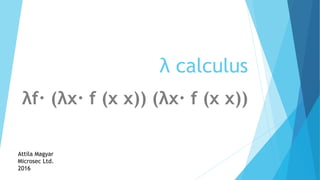Lambda calculus
- 1. λ calculus λf· (λx· f (x x)) (λx· f (x x)) Attila Magyar Microsec Ltd. 2016
- 2. 1930s Turing complete universal model of computation Treats functions "anonymously" Typed or untyped Examples: λx· x (λx· x)y = y
- 3. Syntax // Java (x, y) -> { return x + y; } // Groovy { x, y -> x + y }
- 4. Single input, single output function add(x, y) { return x + y; } add(1, 2); function add(x) { return function(y) { return x + y; } } add(1)(2)
- 5. FizzBuzz 1, 2, Fizz, 4, Buzz, Fizz, 7, 8, Fizz, Buzz, 11, Fizz, 13, 14, FizzBuzz, 16, 17, Fizz, 19, Buzz, Fizz, 22, 23, Fizz, Buzz, 26, Fizz, 28, 29, FizzBuzz, 31, 32, Fizz, 34, Buzz, Fizz, ... Fizz - if divisible by 3 Buzz - if divisible by 5 FizzBuzz - if divisible by 3 and 5 Number - otherwise
- 6. FizzBuzz Java for (int i = 1; i <= 100; i++) { if (i % 15 == 0) { System.out.println("FizzBuzz") } else if (i % 3 == 0) { System.out.println("Fizz"); } else if (i % 5 == 0) { System.out.println("Buzz"); } else { System.out.println(String.valueOf(i)); } }
- 7. Booleans TRUE = { a -> { b -> a } } FALSE = { a -> { b -> b } } E.g.: TRUE(x)(y) == x
- 8. Numbers ZERO = { f -> { x -> x } } ONE = { f -> { x -> f(x) } } TWO = { f -> { x -> f(f(x)) } } THREE = { f -> { x -> f(f(f(x))) } }
- 9. Numbers SUCCESSOR = { n -> { f -> { x -> f(n(f)(x)) } } }
- 10. Predecessor PAIR = { x -> { y -> { f -> f(x)(y) } } } FIRST = { p -> p( { x -> { y -> x } } ) } SECOND = { p -> p( { x -> { y -> y } } ) }
- 11. Predecessor PREDECESSOR = { n -> FIRST( n ({ p -> p({ first -> { second -> PAIR(second)(SUCCESSOR(second)) } }) }) (PAIR(ZERO)(ZERO)) ) }
- 12. Subtract SUB = { n -> { m -> m(PREDECESSOR)(n) } } IS_ZERO = { n -> n( { ignore -> FALSE } )(TRUE) } LTE = { n -> { m -> IS_ZERO(SUB(n)(m)) } }
- 13. Div/Mod def div(n, d) { d > n ? 0 : 1 + div(n - d, d) } def mod(n, m) { m > n ? n : mod(n - m, m) }
- 14. Div/Mod - Y Combinator YC = { le -> ({ f -> f(f) })({ f -> le { x -> f(f)(x) } }) } λf. (λx. f (x x))(λx. f (x x))
- 15. Div/Mod - Y Combinator DIV = YC { recur -> { n -> { d -> LTE(d)(n)({ w -> SUCCESSOR(recur(SUB(n)(d)) (d) ) (w) })(ZERO) } } } MOD = YC { recur -> { n -> { m -> LTE(m)(n)({ w -> recur(SUB(n)(m))(m) (w) })(n) } } }
- 16. DEMO 1
- 17. Lists [False|*] -> [y|*] -> [False|*] -> [x|*] -> [True|True] CAR = { xs -> FIRST(SECOND(xs)) } CDR = { xs -> SECOND(SECOND(xs)) } EMPTY = PAIR(TRUE)(TRUE) IS_EMPTY = FIRST
- 18. Lists CONS = { xs -> { x -> PAIR(FALSE)(PAIR(x)(xs)) } } RANGE = { upto -> upto({ a -> CONS(a)(PREDECESSOR(CAR(a))) })(CONS(EMPTY)(upto)) }
- 19. Lists B = TEN F = ELEVEN I = TWELVE U = THIRTEEN Z = FOURTEEN FIZZ = CONS(CONS(CONS(CONS(EMPTY)(Z))(Z))(I))(F) BUZZ = CONS(CONS(CONS(CONS(EMPTY)(Z))(Z))(U))(B) FIZZBUZZ = CONS(CONS(CONS(CONS(BUZZ)(Z))(Z))(I))(F)
- 20. DEMO 2
- 21. Lists: Fold Left / Fold Right fold( { each, resul_so_far -> each+ resul_so_far }, [1,2,3,4,5] ); [1,2,3,4,5] -> 1 + 2 + 3 + 4 + 5
- 22. Lists: Fold Left / Fold Right FOLDL = YC { recur -> { xs -> { f -> { a -> IS_EMPTY(xs)(a)({ w ->recur(CDR(xs))(f)(f(a)(CAR(xs)))(w) }) } } } } FOLDR = YC { recur -> { xs -> { f -> { a -> IS_EMPTY(xs)(a)({ w-> f(recur(CDR(xs))(f)(a))(CAR(xs))(w) }) } } } }
- 23. Map
- 24. Lists: Map, Reverse MAP = { xs -> { f -> FOLDR(xs)( { lst -> { each -> CONS(lst)( f(each) ) } } )(EMPTY) } } REVERSE = { xs -> FOLDL(xs)( { lst -> { each -> CONS(lst)(each) } } )(EMPTY) }
- 25. DEMO 3
- 26. Num2str NUM2STR = { num -> IS_ZERO(num) ({w -> CONS(EMPTY)(ZERO)(w)})({w2 -> REVERSE(YC { recur -> { n -> IS_ZERO(n)(EMPTY)( {w -> CONS(recur(DIV(n)(TEN)))(MOD(n)(TEN))(w) })}}(num))(w2) }) }
- 27. FizzBuzz GENERATE_FIZZBUZZ = { n -> MAP(RANGE(n))({ each -> IS_ZERO(MOD(each)(FIFTEEN))(FIZZBUZZ)({ w -> IS_ZERO(MOD(each)(FIVE))(BUZZ)({ w2 -> IS_ZERO(MOD(each)(THREE))(FIZZ)(NUM2STR(each))(w2) })(w) }) }) }
- 28. DEMO 4 DEMO 5
- 29. References Church encoding https://en.wikipedia.org/wiki/Church_encoding Programming with nothing by Tom Stuart https://codon.com/programming-with-nothing On Understanding Data Abstraction, Revisited by William R. CooK http://www.cs.utexas.edu/~wcook/Drafts/2009/essay.pdf Ruby Conf 12 - Y Not- Adventures in Functional Programming by Jim Weirich https://www.youtube.com/watch?v=FITJMJjASUs
